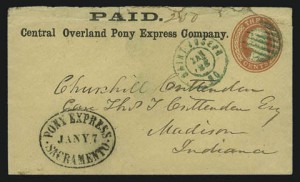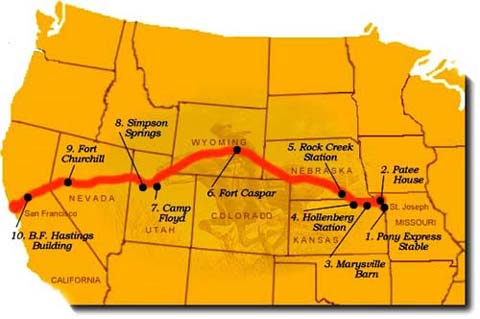
 Today marks the 150th anniversary of the Pony Express.
Today marks the 150th anniversary of the Pony Express.
The Pony Express ran all day and night through summer and winter. There were only 183 men that rode for the Pony Express. The average rider was 20, the youngest rider was 11 and the oldest rider was in his mid 40s. They usually weighed around 120 pounds. They were paid $100 per month. Johnny Fry was the first westbound rider from St. .Joseph. Billy Hamilton was the first eastbound rider from Sacramento. Riders got a new horse every 10 to 15 miles and new riders took over every 75 to 100 miles. It was a dangerous job covering territory at a full gallop and many riders and station keepers were killed. 400 horses (Thoroughbreds, mustangs, pintos and Morgans) were used to stock the route at some 190 relay stations.
From Wikipedia:
“The Pony Express was a fast mail service crossing the North American continent from St. Joseph, Missouri, to Sacramento, California, from April 1860 to October 1861. It became the west’s most direct means of east-west communication before the telegraph and was vital for tying California closely with the Union just before the American Civil War.
“The Pony Express was a mail delivery system of the Leavenworth & Pike’s Peak Express Company of 1849 which in 1850 became the Central Overland California & Pike’s Peak Express Company. This firm was founded by William H. Russell, Alexander Majors, and William B. Waddell.
“The original fast mail services had messages carried by horseback riders in relay across the prairies, plains, deserts, and mountains of the Western United States. For its 18 months of operation, it briefly reduced the time for mail to travel between the Atlantic and Pacific coasts to about ten days.
“By having a shorter route and using mounted riders rather than stagecoaches, the founders of the Pony Express hoped to establish their service as a faster and more reliable conduit for the mail and win an exclusive government mail contract. Pony Express demonstrated that a unified transcontinental system could be built and operated continuously year round. Since its replacement by the telegraph, the Pony Express has become part of the lore of the American West. Its reliance on the ability and endurance of individual riders and horses over technological innovation was part of “American rugged individualism.”
You can get more information at the Pony Express National Museum (St. Joseph, Missouri) website by clicking HERE.
And the U.S. National Park Service recognizes the Pony Express National Historic Trail used by the riders. You can get more information at their website by clicking HERE.
If you have problems seeing the video below click HERE
.youtube::OHQisqylMo4::

